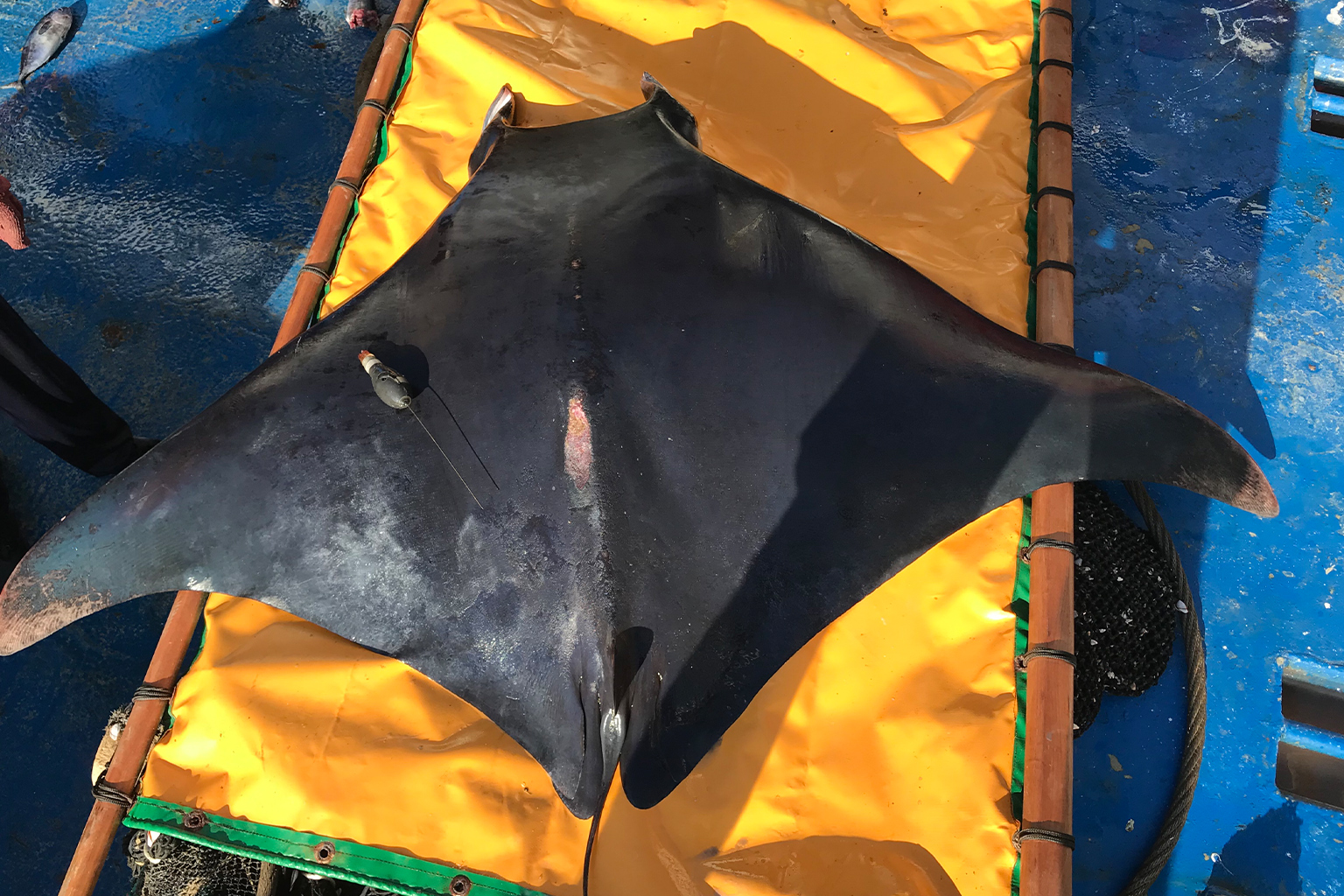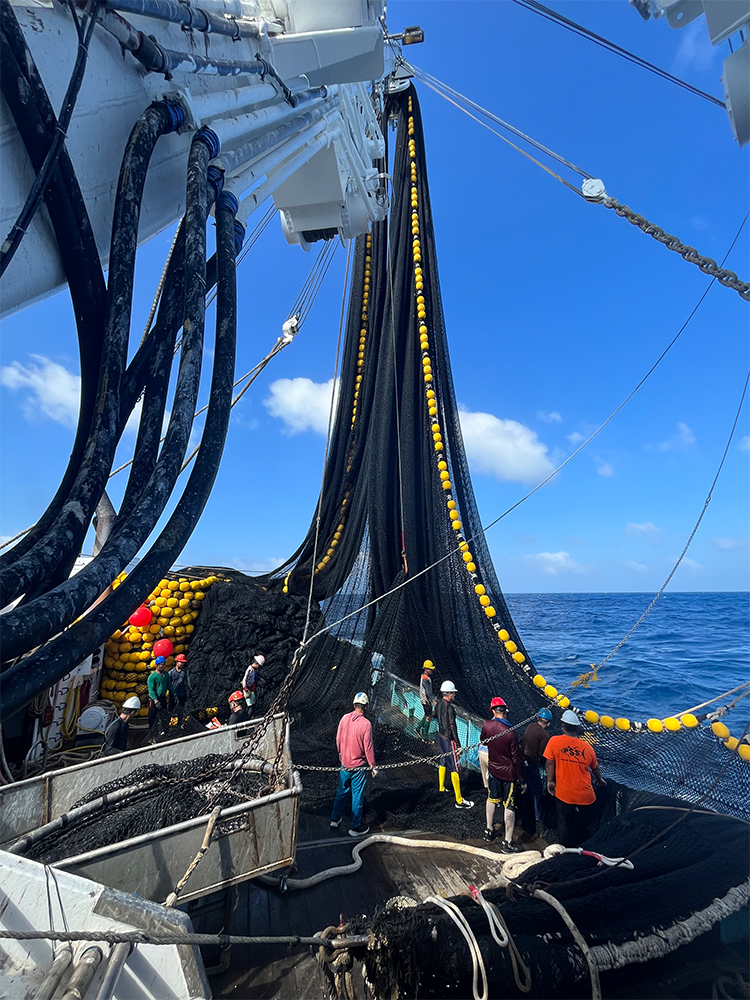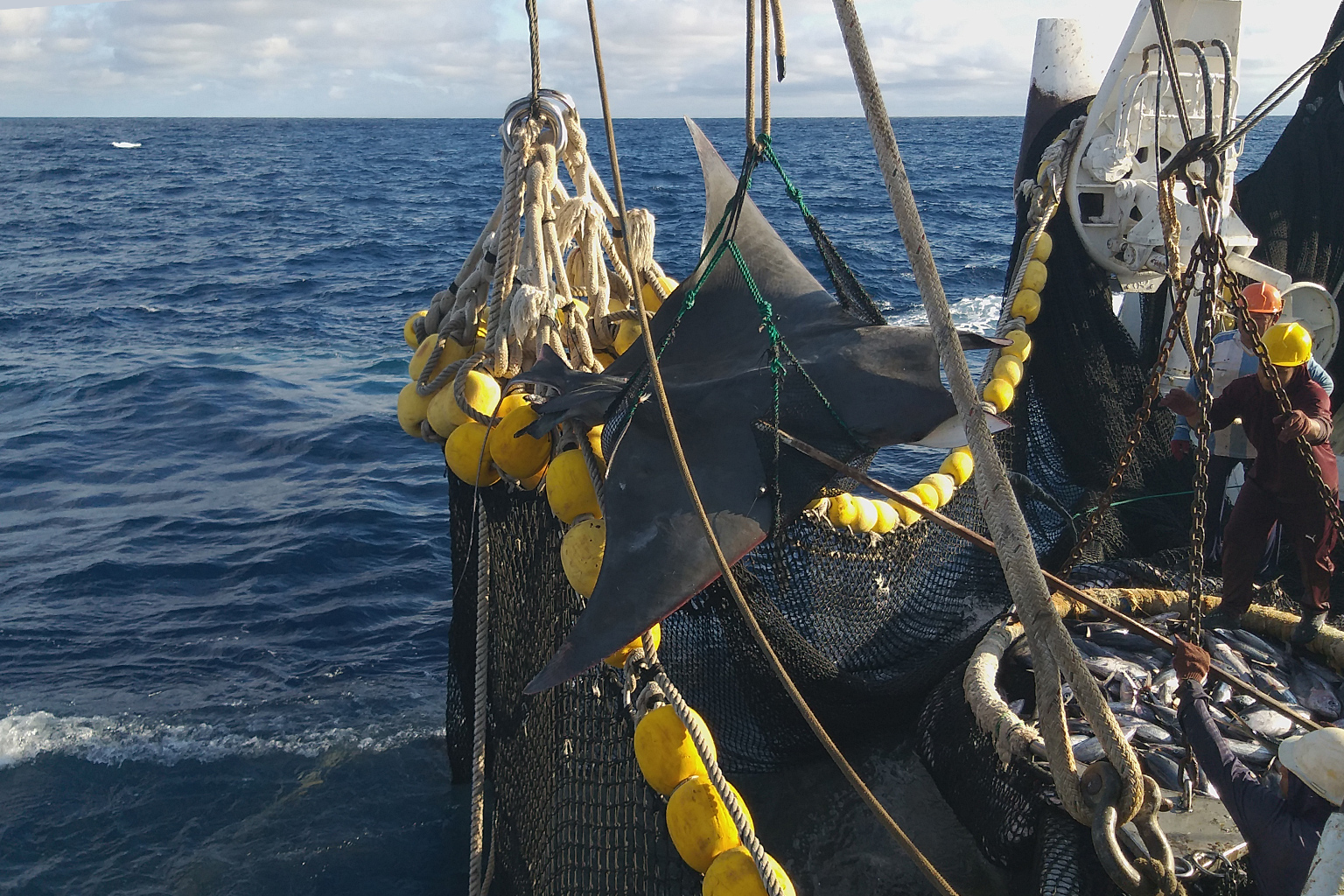- Most species of manta and devil rays (genus Mobula) are endangered, yet industrial purse seine fishing vessels unintentionally catch about 13,000 each year while hunting tuna, according to one scientific estimate.
- New regulations, handling techniques and equipment aim to reduce this number.
- Fishers are working with scientists to return the rays, which are slippery and can weigh as much as a small car, back into the sea when they are brought on deck in fishing nets.
- At the same time, experts warn that far more mobulids die in gillnets set by small-scale and semi-industrial local fishers in countries throughout the tropics.
For half a century, industrial tuna fishing vessels have borne scrutiny for catching animals they haven’t meant to: “bycatch,” in fisheries lingo. Purse seiner vessels, which provide most of the world’s canned tuna, have drawn conservationists’ particular ire for their indiscriminate ways. They operate by dropping a massive cylindrical net and cinching it together at the bottom, like a drawstring purse, so that everything above is caught.
Yet in well-regulated regions, purse seining has become less damaging to marine life over time. First, conservationists and regulators focused on ways to avoid killing dolphins, then sea turtles, then sharks. More recently, manta and devil rays (genus Mobula), most species of which the IUCN lists as Endangered, have become part of the bycatch mitigation agenda.

Mobulids, as these rays are collectively called, glide through the upper layers of tropical and subtropical waters, collecting plankton to eat. Mantas, which tend to be larger than devil rays, have a majestic calmness that’s made them popular among divers. They can grow as wide as a giraffe is tall — which makes dealing with them when they arrive on deck no easy task.
“The real problem is the large individuals,” Melissa Cronin, a postdoctoral fellow at Duke University’s Coasts and Commons Co-Laboratory, told Mongabay. Cronin recently spent six weeks on a purse seiner in the Pacific Ocean as part of a project aimed at studying mobulid populations, bycatch rates and handling techniques. “They are very, very slippery. It’s like holding onto a slippery bar of soap. And they are the [weight] of a Honda Civic.”
Enter the “manta grid,” a simple new device developed collaboratively by scientists and fishers. It’s like a stretcher made of bungee cords that can be moved by crane. In early trials, it’s had success in safely and quickly returning large mantas to the water.
For now, scientists are mainly focused on ways to get the mobulids from the deck back into the water, fully intact, as soon as possible, as with the manta grid. In the long run, they are searching for techniques to avoid catching mobulids altogether, or to remove them from nets while still submerged.

Safer handling
Mobulids are “gentle giants,” as Cronin put it, without stingers, and they pose no threat to humans. Yet fishing crews have never liked having them around.
“They don’t like having a mobulid on board,” Gala Moreno, the coordinator of Cronin’s project and a research scientist with the International Seafood Sustainability Foundation (ISSF), a U.S.-based nonprofit that works on tuna fishery sustainability, told Mongabay. “It’s a nightmare for them.”
In the past, crews resorted to harmful methods to send living mobulids overboard: placing hooks into gills or putting cables through holes in pectoral fins, for example. Scientists say the rays must have died in nearly all such cases, even if they were still alive upon reentering the water.
However, such practices have been banned in many jurisdictions in the last decade, and new ways of handling mobulids are showing promise.
“I was on board 20 years ago and I can tell you things have changed a lot,” Moreno said. “Fishers were not taking care of these species.”
Crews have developed informal slings, nets and stretchers to help remove the fish, and, most promisingly, the manta grid, also called the manta sorting grid. The grid is made of an outer metal rim with a series of crossing bungee cords or ropes — materials that are easy to find on any vessel.

As catch is brought on deck, it can be put through the grid so the tuna pass through but the mobulid is captured, in position to be sent overboard. Trials have shown that mobulids can be released in as little as 1-2 minutes using this method, though it sometimes takes longer, partly because an observer must come to identify the species and tag the ray.
Time is essential because mobulids are perpetual movers that have to pass water through their gills to breathe. The longer they are out of water, the higher their chance of death.
The grids are popular with conservationists and fishers.
“They [the fishers] like the sorting grids because they see, how else could they release a [227-kilogram] 500-pound individual?” Moreno said.
Joshua Stewart, a professor at the Marine Mammal Institute at Oregon State University, has studied mobulid bycatch in the eastern Pacific Ocean since 2017. His preliminary data, based on tagging individuals and tracking them after release, indicates that survival rates vary by species.
Spinetail devil rays (M. mobular), the most frequently caught mobulid, which is relatively small in size, survive capture on purse seiners more than 90% of the time, Stewart told Mongabay. However, size is clearly not the only factor, as the bentfin devil ray (M. thurstoni), another small mobulid, survives less than 10% of the time.
Two larger mobulids, the oceanic manta ray (M. birostris) and the sicklefin devil ray (M. tarapacana), survive capture about half the time, Stewart said — likely much higher than in the past, when rough handling was widespread. Stewart’s data don’t account for the manta grid, which is not yet widely used beyond a handful of Spanish vessels in the Indian Ocean and American vessels in the Pacific Ocean.
Even better solutions may be found earlier in the fishing process: Crews could avoid setting nets, or adjust the nets’ depth, in areas where mobulids are seen or expected. One option is aerial observation. Some purse seiners deploy helicopters to find tuna schools, and pilots can sometimes identify mobulids among the tuna, according to a recent paper by Cronin in ICES Journal of Marine Science. Moreover, with further research on mobulid locations, which another team of scientists is conducting, fishers might be able to use predictive models to avoid areas where they’re aggregating, Cronin said.

If no intervention is possible pre-capture, scientists consider release in the water to be the next best option. Protocols that exist to protect dolphins could be adopted for mobulids: Purse seiners often lower their nets at a certain point — “the backdown maneuver” — and send down snorkelers to guide dolphins out.
Requiring such earlier interventions would be a step up from most current regional regulations, which focus on handling captured rays. For example, the Inter-American Tropical Tuna Commission (IATTC), an intergovernmental body that regulates tuna fishing in the eastern Pacific, instituted new rules and protections for mobulids, banning bad handling techniques in 2015.
Martin Hall, who led the IATTC’s bycatch programs for decades until retiring last year, told Mongabay that a big part of the effort has been education. Many crew members didn’t know that mobulids were threatened or understand the high rate of post-release death, he said. “Once we told them they were killing them”— by puncturing a fin, for example — the crews began to change their approach, he said.
Cronin and Moreno’s current project, which is primarily funded by the National Oceanic and Atmospheric Administration, also includes education. On her recent trip, aboard the Pacific Princess, one of a dozen or so U.S.-flagged tuna purse seiners, Cronin did workshops with the observer and fishers to distinguish between mobulid species — a tricky task, even for an expert. “We’re trying to get fishers on board [with conservation efforts] and want them to feel like part of the solution,” she said.

An even bigger threat
There are between nine and 11 mobulid species, depending on the taxonomist, and all of their populations are in decline. Mobulids are especially vulnerable to overexploitation because they reproduce very slowly: Females bear just one pup every 1-3 years.
Worldwide, more than 600 purse seiners are registered to fish for tropical tuna. There are limited data on their mobulid bycatch, especially outside the eastern Pacific where every vessel carries an observer to document catch, but a 2016 study in Aquatic Conservation estimated that purse seiners capture about 13,000 mobulids per year.
But industrial tuna fishing is not the main problem for mobulids. If the 13,000 estimate is accurate, then purse seining threatens mobulid populations less than the local gillnet fishing that is widespread throughout the tropics.
Small-scale and semi-industrial local fishers set up walls of nylon netting — the gillnets — that can entrap passing mobulids whether or not they are the main target. When they do target mobulids, or at least retain them, it’s usually for their gill plates, which are now sold by traditional Chinese medicine vendors — the subject of numerous media stories in the 2010s.
In fact, gillnet fishing in Sri Lanka alone may kill more mobulids per year than all purse seining globally, a 2021 study in Aquatic Biology showed: More than 17,500 annually on average between 2011 and 2019.


The bad news for mobulids is that Sri Lanka may not be exceptional. Several other countries could have similar catch rates, but it’s hard to be sure without more data, Daniel Fernando, co-founder of Blue Resources Trust, a Sri Lanka-based marine conservation group who co-authored the study with Stewart, told Mongabay.
Fernando said he was worried that the 2010s wave of media attention on mobulids had passed, and conservationists might have become complacent following rules enacted by major intergovernmental bodies and regional fisheries management organizations like IATTC.
“They need to understand, that’s just the first step,” he said.
While the impact on rays from purse seiner bycatch may not be as great as that of gillnet fishing, it’s a serious problem in its own right, and one that is easier to address, now that it is finally getting some attention.
“It’s a centralized, ongoing pressure. We can [eventually] deploy the same solution[s] across the fleet,” Cronin said, explaining why she was focusing her mobulid conservation efforts on purse seiners.
Banner image: A manta ray. The IUCN lists most mobulids as Endangered due to fishing pressures. It’s seen here off the coast of Mexico’s Socorro Island in the Pacific Ocean. Image by Hannes Klostermann / Ocean Image Bank.
Corrections 3/30/23 : We have updated the story to refer to Gala Moreno and Melissa Cronin as scientists rather than as conservationists and also to reflect the fact that the International Seafood Sustainability Foundation (ISSF) is a U.S.-based nonprofit that is no longer headquartered in Virginia.
Indonesian researchers study how to help rays released as bycatch survive
Citations:
Cronin, M. R., Croll, D. A., Hall, M. A., Lezama-Ochoa, N., Lopez, J., Murua, H., … & Moreno, G. (2022). Harnessing stakeholder knowledge for the collaborative development of Mobulid bycatch mitigation strategies in tuna fisheries. ICES Journal of Marine Science. doi:10.1093/icesjms/fsac093
Croll, D. A., Dewar, H., Dulvy, N. K., Fernando, D., Francis, M. P., Galván‐Magaña, F., … & White, W. T. (2016). Vulnerabilities and fisheries impacts: the uncertain future of manta and devil rays. Aquatic Conservation: Marine and Freshwater Ecosystems, 26(3), 562-575. doi:10.1002/aqc.2591
Fernando, D., & Stewart, J. D. (2021). High bycatch rates of manta and devil rays in the “small-scale” artisanal fisheries of Sri Lanka. PeerJ, 9. doi:10.7717/peerj.11994
Lawson, J. M., Fordham, S. V., O’Malley, M. P., Davidson, L. N., Walls, R. H., Heupel, M. R., … & Dulvy, N. K. (2017). Sympathy for the devil: a conservation strategy for devil and manta rays. PeerJ, 5. doi:10.7717/peerj.3027
Murua, J., Ferarios, J. M., Grande, M., Onandia, I., Ruiz, Z., Zudaire, I., & Moreno, G. (2021). Developing solutions to increase survival rates of vulnerable bycatch species in tuna purse seiner FAD fisheries. In: IOTC-2nd ad hoc Working Group on FADs. IOTC-2021-WGFAD02-11_rev1, Online. https://www.bmis-bycatch.org/references/x6fjl4va
FEEDBACK: Use this form to send a message to the editor of this post. If you want to post a public comment, you can do that at the bottom of the page.
